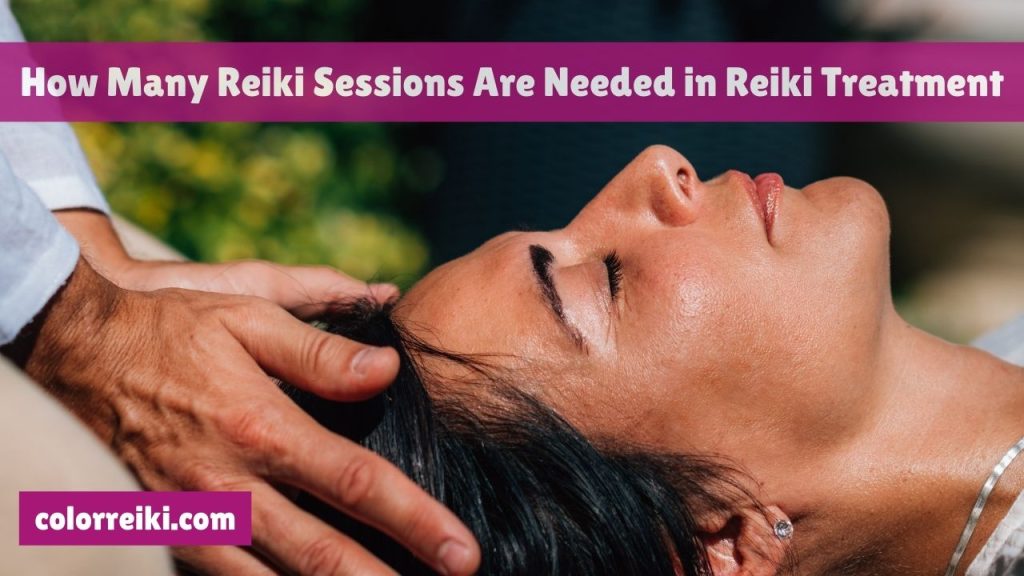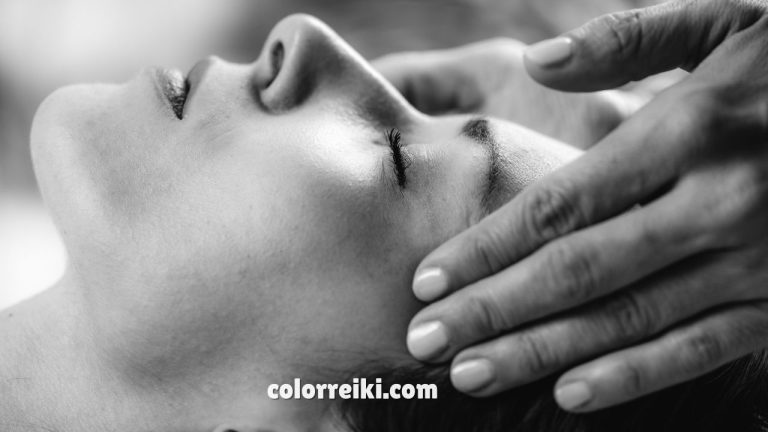How Many Reiki Sessions Are Needed For Your Reiki Treatment
Are you feeling overwhelmed by stress, anxiety, or chronic pain? Do you feel out of balance and disconnected from your inner peace? You’re not alone. Many people struggle with these issues and seek a holistic approach to improve their well-being. Reiki, a Japanese energy healing technique, might be just what you need. Reiki sessions are powerful for relaxation, stress relief, and overall wellness. But you might wonder, “How many Reiki sessions do I need?” and “How often should I get Reiki treatment?“
This guide will delve into these questions, helping you understand how many reiki sessions are needed, the frequency of treatments, and what to expect during your Reiki journey. By the end, you’ll have a clear roadmap to harness the full potential of Reiki for your health and spiritual growth.

Read More: Reiki Principles For Reiki Sessions
Understanding Reiki Sessions: A Beginner’s Guide
Reiki is an amazing practice that promotes relaxation and stress relief by balancing your body’s energy. Practitioners believe that Reiki can help balance the body’s energy, leading to improved health and well-being. During a session, the practitioner channels healing energy into the client’s body through gentle touch or by placing their hands just above the body. This energy helps to clear blockages, restore balance, and promote healing.
How Many Reiki Sessions Are Needed for Beginners?
If you’re new to Reiki, it’s generally recommended to start with 3-5 sessions. This allows you to experience the full range of benefits that Reiki can offer. The first session often introduces you to the process, while subsequent sessions help deepen your understanding and amplify the effects on your body and mind. During these initial sessions, you might notice a gradual release of tension and an increased sense of relaxation and well-being. This foundational phase helps to balance your energy and address any immediate issues or blockages.
The reason for starting with multiple sessions is to give your body and energy system time to adjust to the new influx of energy. Each session builds on the previous one, helping to create a cumulative effect that promotes deeper healing and balance. By the end of the initial series, you should have a good sense of how Reiki affects you and whether you want to continue with regular treatments.
Read More: What is Reiki?
Reiki Sessions for Anxiety: What to Expect and How Many You’ll Need
Reiki can be particularly beneficial for managing anxiety. For those seeking relief from anxiety, 5-7 Reiki sessions are often recommended. These sessions provide consistent support to alleviate anxiety symptoms and promote relaxation. Reiki works by balancing the energy centers in the body, which can reduce stress and help you feel more centered.
Over several sessions, you may notice a significant reduction in anxiety levels, improved sleep, and an overall sense of calm. Each session builds on the previous one, deepening the relaxation response and helping to reprogram the body’s stress response.
Anxiety often involves a cycle of stress and worry that can be hard to break. Reiki helps interrupt this cycle by promoting a state of deep relaxation and peace. As the energy blockages that contribute to anxiety are cleared, you may find it easier to handle stress and experience a greater sense of well-being. Many people find that regular Reiki sessions help them manage their anxiety more effectively and improve their overall quality of life.
The Frequency of Reiki Sessions: How Often Should You Go?
The frequency of Reiki sessions can vary depending on your individual needs and goals. Some people may benefit from weekly sessions, while others may find that bi-weekly or monthly sessions are sufficient. Regular sessions can help maintain the benefits of Reiki, ensuring ongoing support for your physical, emotional, and spiritual health.
1) How Many Energy Healing Sessions Do I Need for Optimal Benefits?
The number of energy healing sessions needed for optimal benefits varies from person to person. Some individuals may notice significant improvements after just a few sessions, while others may require ongoing treatments to achieve and maintain their desired results.
Factors such as the nature of the issue being addressed, the individual’s overall health, and their response to Reiki can all influence the number of sessions needed. Consulting with a Reiki practitioner can help determine the most effective frequency for your unique situation. They can assess your energy balance, discuss your goals, and recommend a personalized treatment plan.
For chronic conditions or deep-seated issues, more frequent sessions might be necessary initially, tapering off as the condition improves. For general maintenance and well-being, a monthly session might suffice. It’s essential to communicate with your practitioner and listen to your body to determine what works best for you. Regular feedback and adjustment of your treatment plan can help you achieve the best outcomes.
2) What to Expect After Your First Reiki Session: A Comprehensive Guide
After your first Reiki session, you may feel a range of sensations including relaxation, calmness, and a sense of being centered. This is a normal response as your body begins to release tension and stress. Some people might feel energized, while others may feel a need to rest and integrate the experience. It’s important to listen to your body and give yourself the time to process the effects of the session. Drinking plenty of water and taking some quiet time can help enhance the benefits. This initial session sets the stage for deeper healing in subsequent treatments.
You might also experience an emotional release, such as feeling more sensitive or having vivid dreams. These reactions are part of the healing process as blocked energies and emotions are released. If you experience any discomfort or strong emotional reactions, it’s important to communicate this with your practitioner. They can provide support and guidance to help you navigate these experiences. Over time, you should notice a gradual improvement in your overall well-being and a greater sense of balance.
3) How Many Reiki Sessions Needed to Quit Smoking?
Reiki can support smoking cessation by addressing the underlying stress and emotional factors associated with the habit. Typically, 5-10 sessions may be needed to experience significant benefits. These sessions help reduce cravings, manage withdrawal symptoms, and support emotional balance. Reiki promotes relaxation and helps to clear negative energy patterns, making it easier to break the addiction cycle. A consistent treatment plan, combined with other cessation strategies, can significantly enhance your chances of quitting smoking successfully.
Quitting smoking is a challenging process that often involves dealing with physical cravings and emotional triggers. Reiki helps by reducing stress, which is a common trigger for smoking. By promoting a sense of calm and balance, Reiki can make it easier to resist cravings and stick to your cessation plan. Regular sessions during the quitting process can provide the support you need to overcome obstacles and achieve your goal.
Reiki Session Cost: Understanding the Investment in Your Healing
The cost of Reiki sessions varies depending on location, practitioner experience, and session length. Investing in Reiki can lead to long-term benefits and potential savings on healthcare costs. On average, a Reiki session might cost between $50 and $100 per hour. While this might seem like a considerable investment, the benefits of reduced stress, improved health, and enhanced well-being can far outweigh the costs. Additionally, some practitioners offer package deals or sliding scale fees to make Reiki more accessible. Understanding the financial commitment can help you plan your sessions accordingly.
When considering the cost, it’s important to think about the value of your health and well-being. Regular Reiki sessions can prevent illness, reduce the need for medication, and improve your quality of life. Over time, the benefits of Reiki can translate into fewer healthcare expenses and a more balanced, healthier life. Discussing your budget and treatment goals with your practitioner can help you find a plan that fits your needs and financial situation.
Reiki Session Duration: How Long Does a Typical Session Take?
Reiki sessions typically last between 30 to 60 minutes. This duration allows for a full and relaxing experience, during which the practitioner channels healing energy to various parts of your body. Shorter sessions may be used for targeted healing or maintenance, while longer sessions provide a more comprehensive treatment. The practitioner will guide you through the process, ensuring you feel comfortable and relaxed throughout the session. This time frame is sufficient to achieve a deep state of relaxation and initiate the healing process.
The length of the session can vary depending on your needs and the practitioner’s approach. Some practitioners offer extended sessions that last up to 90 minutes for a more in-depth experience. During the session, you may feel warmth, tingling, or a sense of deep relaxation as the energy flows through your body. The practitioner may also focus on specific areas where you have issues or blockages. After the session, it’s important to take some time to rest and allow the healing energy to integrate.
Money and Reiki Frequency: Understanding the Connection
Regular Reiki sessions can lead to cost savings in the long run. By investing in your health through Reiki, you may reduce the need for other medical treatments or interventions. Over time, the benefits of Reiki can enhance your overall well-being, potentially decreasing your reliance on medication and doctor visits. This holistic approach to health can be a cost-effective way to maintain balance and prevent illness. Additionally, many people find that the stress reduction and emotional healing provided by Reiki are invaluable, further justifying the investment.
By maintaining regular Reiki sessions, you can support your body’s natural healing processes and prevent the onset of stress-related conditions. This proactive approach to health can save you money on healthcare costs by reducing the need for expensive treatments and medications. Investing in your well-being through Reiki is a commitment to a healthier, more balanced life. It’s an investment in yourself that can pay off in numerous ways, including improved physical health, emotional stability, and overall quality of life.
The Purpose of Attending Reiki Sessions: What to Expect and How Many You’ll Need
Attending Reiki sessions can promote relaxation, stress relief, and overall well-being. Understanding the purpose and benefits of Reiki can help you determine the optimal number of sessions. Regular sessions can help maintain energy balance, support emotional health, and enhance your spiritual growth. The number of sessions you need will depend on your specific goals, such as pain relief, emotional healing, or personal growth. Working with a Reiki practitioner can provide personalized insights into the best treatment plan for your needs.
Reiki sessions are designed to support your body’s natural ability to heal and maintain balance. By addressing the underlying energy imbalances that contribute to physical and emotional issues, Reiki can promote a sense of well-being and harmony. Regular sessions can help you stay grounded and connected, making it easier to navigate life’s challenges. Whether you’re seeking relief from a specific condition or looking to enhance your overall health, Reiki can provide the support you need to achieve your goals.
Recommended Number of Reiki Sessions: A Guide for Beginners and Seasoned Practitioners
The recommended number of Reiki sessions varies depending on individual needs and goals. Beginners might start with 3-5 sessions to establish a foundation, while seasoned practitioners may attend sessions as needed for maintenance or deeper healing. For ongoing support, many people find that monthly sessions help maintain their energy balance and overall health. Regularly consulting with your Reiki practitioner can help adjust the frequency of your sessions based on your evolving needs and experiences.
For those dealing with chronic conditions or significant stress, more frequent sessions may be necessary initially. As your condition improves, you can reduce the frequency of sessions to maintain the benefits. Seasoned practitioners often use Reiki as a tool for ongoing personal growth and spiritual development, attending sessions as needed to support their journey. By staying in tune with your body and working closely with your practitioner, you can create a Reiki plan that supports your health and well-being.
Conclusion
In conclusion, the number of Reiki treatments needed varies depending on individual goals, needs, and circumstances. By understanding the basics of Reiki sessions, frequency, and duration, you can maximize the benefits of this powerful tool for relaxation, stress relief, and overall well-being. Consult with a Reiki practitioner to determine the best schedule for your specific needs. Whether you are a beginner or a seasoned practitioner, regular Reiki sessions can support your journey toward health and spiritual growth. By investing in Reiki, you can enhance your quality of life, reduce stress, and achieve a balanced state of well-being.
FAQs About Reiki Sessions
1. List 5 Benefits of Reiki Sessions. What to Expect and How Many You’ll Need
Reiki sessions can promote relaxation, stress relief, pain relief, emotional healing, and overall well-being. The number of sessions needed to experience these benefits can vary. Generally, 3-5 sessions are recommended to start seeing significant improvements. Consistent sessions can help deepen these benefits, providing ongoing support for your physical and emotional health. Regular Reiki treatments can lead to a cumulative effect, enhancing your overall quality of life.
2. What Does a Reiki Practitioner Feel During a Session?
During a Reiki session, practitioners often feel a flow of energy, warmth, or tingling sensations in their hands as they channel healing energy. These sensations are indicators that the energy is being transmitted effectively. Practitioners might also experience intuitive insights about the areas that need healing. This feedback helps them guide the session to address specific issues or imbalances in the client’s energy field. The practitioner’s sensitivity to these sensations can enhance the effectiveness of the treatment.
3. How Long Does Reiki Healing Last? Can I Take Reiki Every Day?
The effects of Reiki healing can last for several days to weeks, depending on the individual and their specific situation. Some people may feel immediate relief, while others notice gradual improvements over time.
Daily Reiki sessions can be beneficial for those dealing with acute issues or seeking intensive healing, but most people find that weekly or bi-weekly sessions are sufficient to maintain balance and well-being. It’s important to work with your Reiki practitioner to determine the best frequency for your needs. Regular sessions can help sustain the benefits of Reiki and support long-term health and healing.
4. Can Reiki Work? How Many Sessions Are Recommended?
Reiki can be a powerful tool for relaxation, stress relief, and overall well-being. The number of sessions recommended varies depending on individual goals and needs. For general well-being, 3-5 sessions are often sufficient to experience noticeable benefits. For specific issues such as chronic pain or emotional healing, more sessions may be required. Working with a Reiki practitioner can help tailor the treatment plan to your unique situation, ensuring you receive the optimal number of sessions for your healing journey.
5. How Long Is a Reiki Session? What to Expect and How Many You’ll Need?
Reiki sessions typically last 30-60 minutes. During this time, you can expect to lie down fully clothed while the practitioner places their hands lightly on or just above your body in various positions. This process helps channel healing energy to where it is most needed.
The number of sessions needed will depend on your specific goals and the progress you experience. Regular sessions can help maintain the benefits and support ongoing healing. Discussing your needs and expectations with your practitioner can help determine the best session length and frequency for you.






